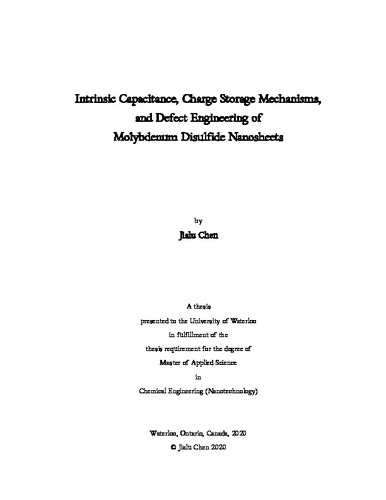| dc.description.abstract | Single layer 2D materials such as the metallic, 1T polymorph of molybdenum disulfide (MoS2) hold significant promise for next-generation supercapacitors due to their high theoretical surface area and ability to be assembled into electrodes with high bulk density boosting volumetric capacitance. While significant research has emerged in the last few years devoted to MoS2 and graphene-MoS2 hybrid electrode systems, little is known regarding fundamental double-layer charging mechanisms in this system. In this work, we determine the potential and frequency dependent area-specific double-layer capacitance of the electrode/electrolyte interface using the 1T and 2H polymorphs of MoS2. Furthermore, we aim to understand restacking effects and possible intercalation mechanisms in multilayer MoS2 films, as well as how the intrinsic capacitance can be enhanced by defect engineering.
To by-pass the challenges and uncertainties associated with porous electrodes, we carry out measurements on non-porous monolayer electrodes supported by atomically flat graphite single crystals. Monolayer films were prepared by using a variation of the Langmuir Blodgett deposition method to create films of chemically exfoliated molybdenum disulfide (MoS2) and chemically reduced graphene oxide (rGO) using a recently developed barrier-free densification method. The films were characterized to determine surface coverage, surface roughness, layer number and electrode material chemistry. The frequency and voltage-dependent capacitance of monolayer, bilayer, and trilayer films were measured by cyclic voltammetry and impedance spectroscopy.
The results demonstrate that the metallic 1T polymorph of MoS2 (Ca,1T = 14.9 µF/cm2) has over tenfold the capacitance of the semiconducting 2H polymorph (Ca,2H = 1.35 µF/cm2) near the open circuit potential and under negative polarization in aqueous electrolyte. However, under positive polarization the capacitance is significantly reduced and behaves similarly to the 2H polymorph. While the capacitance of rGO films does not increase with increasing layer number, the capacitance of 1T-MoS2 films scaled with layer number, even at high frequency, suggesting easy and rapid ion intercalation between the restacked sheets. The results of these studies allow us to determine the limiting factors and upper limits of capacitance expected from MoS2 composites and provides engineering design criteria for building higher performance MoS2 composite electrodes.
Furthermore, in order to extend the potential upper capacitance limits of MoS2 supercapacitors, defect engineering is explored in MoS2 nanosheet films. Two types of defects are introduced into MoS2: sulfur vacancies and edge sites. Sulfur vacancies are created by increasing the amount of lithium intercalant used while edge sites are produced simply by decreasing the lateral size of MoS2 nanosheets through sonication. When transitioning from 0% to 6.6% sulfur vacancies, the intrinsic capacitance increases consistently. Conversely, while decreasing flake size by 40 nm increases the measured capacitance, further size reduction by 80 nm results in decreased capacitance. These results demonstrate that defect engineering through careful tuning of MoS2 nanosheet synthesis allows for considerable improvements to the intrinsic capacitance. | en |

